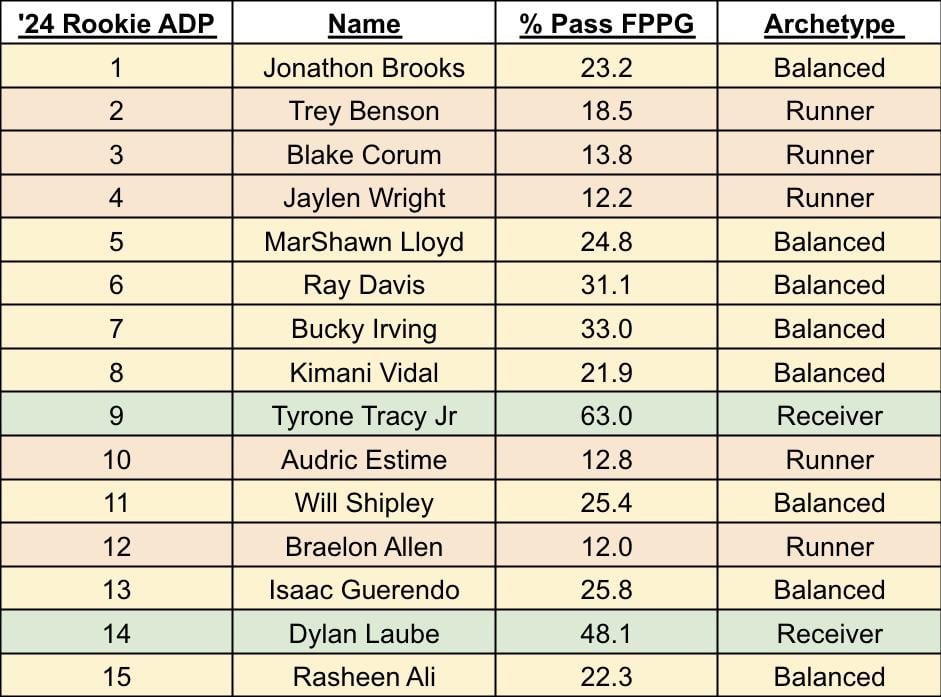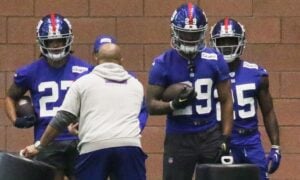Dynasty Archetypes: Running Back

As a dynasty manager, imagine having the ability to accurately predict the future performance of a player, based on the past…
In this new series, I’ll be exploring ‘Dynasty Archetypes’, a method of predicting future player fantasy production based upon grouping players with similar traits, usage and output. By understanding a player projection or expected journey based on the results of similar player types, it is easier to calculate the range of outcomes of the asset and facilitate the optimal team build.
In the previous article, I outlined the different archetypes of quarterback. The focus is now shifting to running back – the highest risk/reward position in dynasty. The running back archetypes used in this article are relatively simple, with the key driver focusing on the percentage of fantasy points per game achieved through passing production (PFPPG) – receptions, receiving yards and receiving touchdowns. The parameters for the running back archetypes are: 0-20% PFPPG for ‘runner’, 20-40% ‘balanced’ and 40%+ for the ‘receiver’ running back archetype.
Running Back Archetypes
Receiver
The year is no longer 2002 and the most common league format isn’t standard scoring. We are in the era of points per reception (PPR), where the most sought-after running back archetype is ‘receiver’. While it should be noted the role is not specific for purely receiving work, I’ve grouped players in this bucket on the basis of 40%+ of their fantasy production coming through the passing game.
When considering the high end of this archetype within dynasty rankings, there is still an underlying production through the running game, as this balance negates any game script concerns, where a pure receiving back would only be viable playing from behind. On the lower end of the scale, there can be receiver archetypes who lack an overall skill set and whilst scoring well in PFPPG, the true overall output of fantasy points is diminished as volume is reduced.
If you can identify players within this archetype who also have a well-rounded profile, an ability to play all three downs, this is where you gain access to the excellent floor-ceiling combination. The receiver archetype ages better than other archetypes due to the nature of the role, touches in open space, and less impact from the massive defenders in the trenches, most common with the run game. It also provides an opportunity for the fastest and largest rise to player value when hitting this archetype. While the graphic below shows the top 15 scorers in fantasy points per game (FPPG) in 2023, it should also be noted that consensus dynasty RB1 Bijan Robinson also lands within this archetype – with an output of 50%+ in PFPPG.

The ‘receiver’ archetype is prominent within the top FPPG in 2023, with Travis Etienne and Jahmyr Gibbs also close to this threshold (Credit: DLF Game Log App).
Balanced
The majority of the dynasty landscape at running back group within the balanced archetype, with a well-rounded profile from a scoring perspective and solid usage in any game environment. The core value of displaying true game script-proof ability makes this archetype appealing.
As the largest group, the balanced archetype has a wide spectrum overall – with the higher end of this archetype turning into solid RB1s. Volume is the underlying driver, where reduced touches make this more risky than the receiver archetype, due to less exposure to the preferential work in the passing game. As dynasty managers are keen on the receiver archetype, the balanced grouping is cheaper in market value.
The balanced archetype is the most fluid year to year, where a player could swing to either the runner or receiver type in any given season. The true archetype will remain long-term, however the change in environment and situation could be adverse or favorable on a yearly basis. The inverse of this is the recent years of Joe Mixon, where he was previously a balanced archetype, with the last two years shifting to the receiver archetype. It should be noted his best season came under the balanced archetype due to the highest volume of his career and an outlier spike in overall touchdowns.
Runner
Without a doubt, the riskiest running back archetype is ‘runner’, with limited pass game work resulting in minimal exposure to the floor-ceiling combination of PPR leagues. Similar to the receiver archetype, this can be volatile with game script – where trailing teams abandon the run and make this asset’s core scoring redundant. On this basis, the archetype is volatile week to week.
The archetype is based upon rushing volume and touchdown opportunity, where situation is crucial. There can be successful seasons with this archetype. For example, in 2023, David Montgomery produced a top-15 FPPG season with a huge spike in touchdowns (13). On a lower volume, Gus Edwards was able to finish as a top-25 RB, aided by 13 touchdowns on the ground. Landing a runner archetype with goal-line work and on a potent offense like the Lions or Ravens can lead to solid fantasy production.
The runner archetype is the cheapest to acquire and while it is the most risky running back asset, it can still be successful in dynasty leagues. With many managers building teams on a zero or hero RB build (less focus on high-value running backs), the runner archetype contributes to filling the hole within dynasty rosters. Taking shots on running backs can land a runner archetype who falls into volume. Thinking about 2024, guys like Zamir White and Ezekiel Elliott are cheaper options who fit this archetype and could have intriguing seasons with touchdown spikes, however view these as short-term assets due to their overall flaws.

The 2024 running back class lacks the floor-ceiling combination of receiver archetypes to produce elite dynasty production (Credit: Sports Reference College Football).
2024 Rookie Application
The first thing to note is the PFPPG is lower in college, leading to hope for a positive shift in archetype to higher floor-ceiling groupings upon entering the NFL. With this in mind, the overall quality of the 2024 running back class remains poor, littered with risky, volatile players who own a low floor and ceiling combination. Dynasty managers looking for the game-changing RB1 type are in for a shock.
Based on PFPPG, the consensus top five in ADP look slightly overrated when considering their running back archetype. It’s not to say there can’t be a positive shift in grouping or for the archetype to be useful in dynasty leagues, just a lower probability of solid fantasy performance. Both Ray Davis and Bucky Irving are the most likely to make the jump to the coveted receiver archetype, making them appealing upside selections in round three of rookie drafts.
The 2024 running back class highlights a couple of intriguing receiver profiles with unique college backgrounds. Tyrone Tracy Jr has the highest PFPPG of the top prospects – aided by a college career beginning as a wide receiver. Also, Dylan Laube is a small-school prospect with outstanding receiving production, a huge projection at the next level. Focusing on the runner archetype, the profiles of Braelon Allen and Audric Estime look like poor dart throw options at their current ADP, taking on risky archetypes where situation is huge to their future value. There is hope for Estime in a post-Javonte Williams backfield, however unlikely, whereas Allen lands behind Hall – a terrible combination of situation and archetype.
Overall
The market perception is clear on running back archetypes, where receiver is in high demand and runner is less so. While the high-end outcome of the receiver archetype is the goal for a dynasty team’s RB1 or the final piece for the championship push, the other archetypes are useful and more cost-effective.
Aiming to have more emphasis on receiver and balanced archetypes as your RB1 is key, however as you’re likely to attribute 30-40% of your roster to running back, the archetype will be driven more by cost than range of outcomes. There is more risk in a runner archetype, however, in comparison to other positions, running back carries plenty of injury risk and volatility. Making calculated moves based on short-term value and production is a wise move for the position.
The aforementioned Davis and Irving are clear targets from the data, however I also want to highlight MarShawn Lloyd as a player who will be used primarily in the passing game (receiver archetype potential) and a pathway to a major role by 2025. On the opposite side, there are no real concerns about archetypes other than those outlined previously – but potentially Trey Benson if his cost became prohibitive.
The dynasty archetypes I’ve used in this article are a guideline, where you can tweak and create your own, base it on other specific metrics, body type etc. The idea is to highlight that grouping players can help you predict future players with similar characteristics, allowing you to formulate a strategy to acquire a perfect blend of archetypes, setting you up to win in your dynasty leagues. Overall, the 2024 running back class is weak, with poor upside however there are intriguing profiles at cost, resulting in the opportunity to build depth at the position and bolster your dynasty rosters.
- Dynasty Archetypes: Tight End - June 22, 2024
- Dynasty Archetypes: Wide Receiver - June 6, 2024
- Dynasty Archetypes: Running Back - May 24, 2024


































































